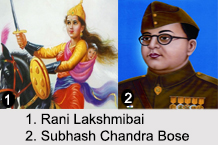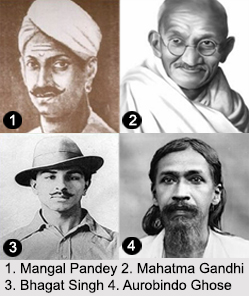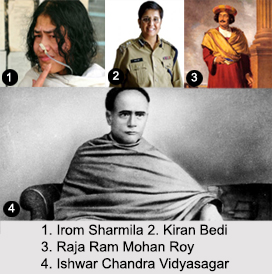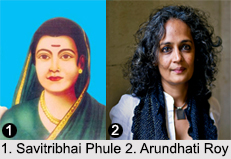 Indian revolutionaries shot to prominence during the first half of the 20th century. Revolutionary movement for Indian independence is a part of the Indian independence movement. The revolutionary groups were mostly focused in Bengal, Maharashtra, Bihar, and Punjab. More groups were spread across India.
Indian revolutionaries shot to prominence during the first half of the 20th century. Revolutionary movement for Indian independence is a part of the Indian independence movement. The revolutionary groups were mostly focused in Bengal, Maharashtra, Bihar, and Punjab. More groups were spread across India.
Famous Indian Revolutionaries
Following are the famous Indian Revolutionaries:
Aurobindo Ghose: He joined the Indian independence movement from British rule. He was one of its powerful leaders for a while and then became a religious reformer, introducing his visions on human progress and spiritual evolution. He formed the "Jugantar" (one of the two main secret revolutionary trends operating in Bengal for Indian independence) party in April 1906.
Sukhdev Thapar: He was an Indian revolutionary. He was an elder member of Hindustan Socialist Republican Association. He was hanged on 23rd March 1931 at the age of 23 years. He managed revolutionary cells in Punjab and other areas of North India.
Hemchandra Kanungo Das: He was probably the first revolutionary from India who went abroad to obtain military and political training. He opened a secret bomb factory "Anusilonee Somitee" at Maniktala near Kolkata.
Khudiram Bose: He was an Indian Bengali revolutionary, one of the youngest revolutionaries early in the revolutionary movement for Indian independence. He joined "Jugantar" - the party of revolutionary activists.
 Chandra Shekhar Azad: He was an Indian revolutionary who changed the Hindustan Republican Association under its new name of Hindustan Socialist Republican Army. He was also a close friend of Bhagwati Charan Vohra who along with Bhagat Singh, Sukhdev, and Rajguru, helped him to achieve their main aim of an independent India based on socialist principle.
Chandra Shekhar Azad: He was an Indian revolutionary who changed the Hindustan Republican Association under its new name of Hindustan Socialist Republican Army. He was also a close friend of Bhagwati Charan Vohra who along with Bhagat Singh, Sukhdev, and Rajguru, helped him to achieve their main aim of an independent India based on socialist principle.
Bhagat Singh: He was an Indian socialist revolutionary Nationalist. He is considered to be one of the most powerful revolutionaries of Indian Nationalist Movement. He died a martyr at the age of just 23 years.
Shivaram Rajguru: He was an Indian revolutionary from Maharashtra who celebrated mostly for his involvement in the shooting of a British Raj police officer. He was recognized under the pseudonym of Raghunath. He believed that fierceness against domination was far more successful against British rule than the non-violent civil disobedience preferred by Mahatma Gandhi.
Lala Lajpat Rai: He was an Indian freedom fighter. He played a fundamental role in the Indian Independence movement. He was popularly known as Punjab Kesari. He was elected President of the Indian National Congress in the Calcutta Special Session of 1920. He founded "Servants of the People Society", a non-profit welfare organisation.
Mahatma Gandhi: He as an Indian activist who was the principal of the Indian independence movement against British rule. He led India to independence and inspired movements for civil rights and freedom across the world. He is informally called the Father of the Nation.
B.R. Ambedkar: Bhim Rao Ambedkar was a foremost activist and social reformer who gave his life working for the upliftment of the "Dalits" and the socially backward class of India. He acted as a revivalist of Buddhism in India. He constantly fought for abolition of caste inequity.
Bal Gangadhar Tilak: He is famous as "Lokmanya" and was a teacher and journalist by profession. He initiated his political life as a Maratha propagandist but soon developed into a well-known nationalist. He was the first ever principal to advocate the need for "Swaraj" or "Self Rule".
Mangal Pandey: He was an Indian soldier who played a major role in inciting the Indian rebellion of 1857. He was a sepoy serving with the British East India Company, he protested against the problem of greased cartridge to the soldiers.
Rani Lakshmibai: He is famously known as "Jhansi Ki Rani" and was one of the leading warriors in India"s First War of Independence, which was fought in 1857. She revolted against British with the help of other Indian rebellion leaders. She inspired many generations of freedom fighters in India.
Subhash Chandra Bose: He was the founder of Indian National Army, more popularly known as "Azad Hind Fauj". He was a rebel and he joined the Indian National Congress and later became its president. He was a freedom fighter.
Ishwar Chandra Vidyasagar: He is considered as one of the leaders of Bengal revival. He was a well-known writer, academic and above all a staunch follower of humanity. He brought a revolution in the education system of Bengal.
Jyotiba Phule: He was one of the major social reformers. He led the movement against the established caste-restrictions in India. He revolted against the dominion of the Brahmins.
Raja Ram Mohan Roy: He is considered as the pioneer of modern Indian Renaissance for the significant. Among his endeavours, the elimination of the sati-pratha-a practice in which the widow was forced to sacrifice herself on the funeral pyre of her husband.
Aruna Roy: She is best known for her endeavours to fight corruption and prop up government precision. She is famous as a leader of the Mazdoor Kisan Shakti Sangathan. She played a crucial role in establishing the Right to Information Act (RTI).
Kiran Bedi: She is a social activist and the first woman Indian Police Service (IPS) officer in the country. She has not only served her department with full sincerity, but has also made sincere contribution to several social causes.
Arundhati Roy: She is best known for the award-winning novel "The God of Small Things" (1997) and for her participation in environmental and human rights causes. She has campaigned along with activist Medha Patkar against the Narmada dam project.
Irom Sharmila: She is popularly known as the "Iron Lady of Manipur". She began a hunger strike after the “Malom Massacreâ€. It has been 16 years since she started her movement.
Manasi Pradhan: She is the initiator of Nirbhaya Vahini and OYSS Women and head the Honour for Women National Campaign, a nationwide movement to end violence against women in India. She is also serving on the panel of Central Board of Film Certification (Censor Board) for India. She is a member of the International Governing Council of World Women Organization (WWO) and Inquiry Committee of the National Commission for Women.
 Laxmi Agarwal: She is an acid attack survivor and speaks for the rights of acid attack victims. She has also advocated against acid attacks through gathering 27,000 signatures for a petition to curb acid sales, and taking that cause to the Indian Supreme Court. Her petition led the Supreme Court to order the central and state governments to regulate the sale of acid, and the Parliament to make prosecutions of acid attacks easier to pursue. She is the director of Chhanv Foundation, a NGO dedicated to help the survivors of acid attacks in India.
Laxmi Agarwal: She is an acid attack survivor and speaks for the rights of acid attack victims. She has also advocated against acid attacks through gathering 27,000 signatures for a petition to curb acid sales, and taking that cause to the Indian Supreme Court. Her petition led the Supreme Court to order the central and state governments to regulate the sale of acid, and the Parliament to make prosecutions of acid attacks easier to pursue. She is the director of Chhanv Foundation, a NGO dedicated to help the survivors of acid attacks in India.
Usha Mehta: She activated a secret radio transmitter when the Government tried to repress news about the Quit India movement. She was arrested by the Criminal Investigation Department but did not give out any secrets.
Savitribhai Phule: She is considered as one of the pioneers of women"s education in India in the British rule. She founded the first women"s school in India at Bhide Wada, Pune in 1848. She fought for women rights and even for those who were considered untouchables in those times.
Sarojini Naidu: She was a spirited freedom activist and a poet, who took part in the Civil Disobedience movement of 1930-34. She was the first woman governor of independent India.
Other famous Indian Revolutionaries are Vasudeo Balwant Phadke, Lokenath Bal, Pritilata Waddedar, Sachindra Nath Sanyal, Pramathanath Mitra, Jatindra Mohan Sengupta, Kalpana Datta, Bhupendranath Datta, Kanailal Dutta, Bipin Chandra Pal, Ambika Chakrabarty, Roshan Singh, Baikuntha Shukla and so on.



















